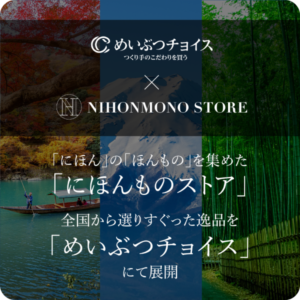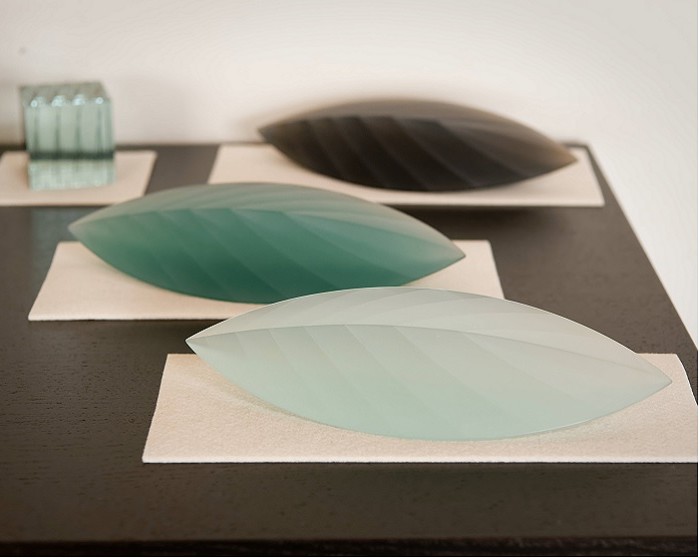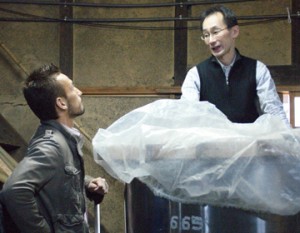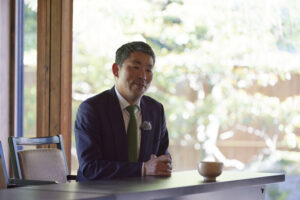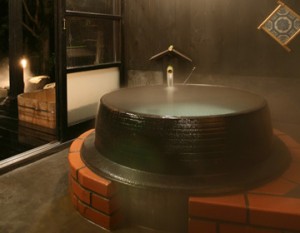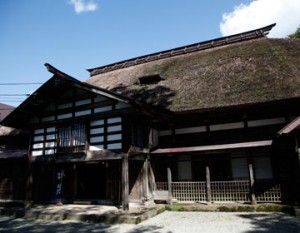Yukako Kojima is a glass artist living in Toyama City, Toyama Prefecture. Her unique style of work has attracted attention both in Japan and overseas, and she says that this is because she lives in Toyama. She loves the local culture of Toyama and makes things, but she was born in Ishikawa Prefecture and spent her first five years in Aichi Prefecture before moving to Chiba Prefecture. She says that there were many encounters that led her to work in Toyama after growing up outside the prefecture.
“Making things is fun” was the starting point for me as an artist.
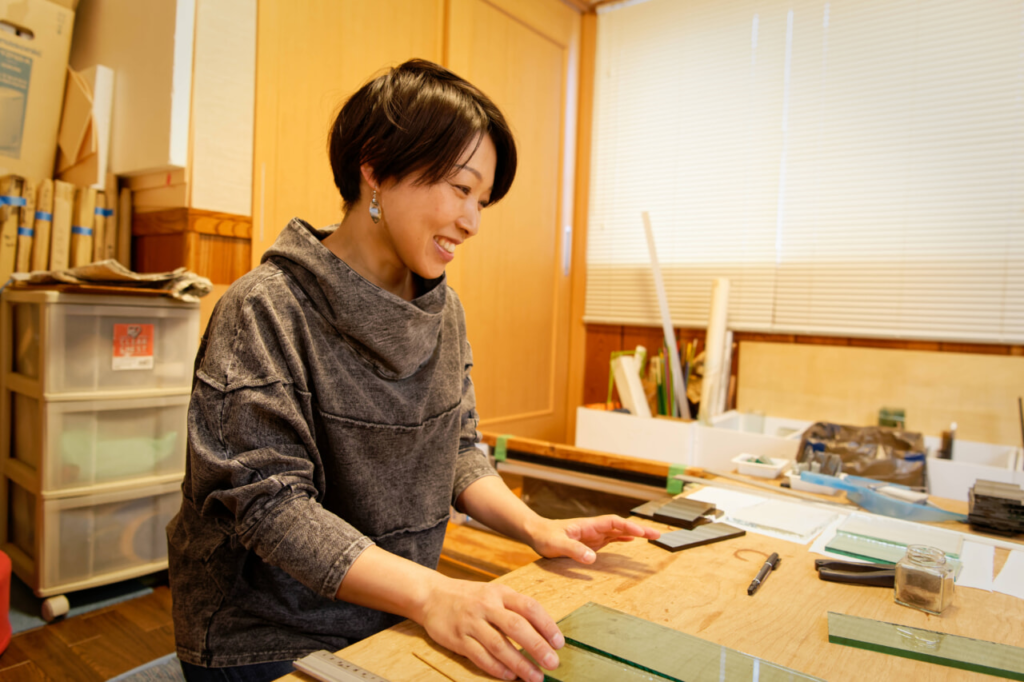
In front of his own work, Kojima-san smiles and says, “I often get asked by customers who have seen my work, ‘How is this made? It’s certainly a strange piece of work. After being captivated by its beauty, you want to touch it and hold it up to the light. Is the surface smooth or uneven? What would it look like if you looked at it from that direction?
The more you look at it, the more you are drawn into the charm of this glass art. These are works made from laminated glass. Laminated glass is a technique that involves layering sheets of glass used in construction, such as window glass, and then showing the cross-section of the glass. By devising ways of layering and cutting the materials, it is possible to create patterns and express the unique texture of glass. This technique is used in objects that decorate apartments and hotels.
The person who uses this technique to create her work is Yukako Kojima. She was born in Ishikawa Prefecture and grew up with a mother who had graduated from an art college. Although her mother never became an artist, she continued to make things as a hobby, and so Yukako has always been surrounded by the creative process. In addition, the high school she attended was unusual in that, as part of the elective subjects, she could choose to take classes in “crafts” as well as “art”, “music” and “calligraphy”.
This class was the catalyst that made him realize the appeal of crafts, and he decided to go on to an art university with a faculty of crafts. However, at that point, he had no idea that he would end up pursuing a career in glass crafts. The reason he ended up going into glass was a simple choice he made when taking his university entrance exams, so it makes you realize that chance encounters can hold great potential.
My encounter with glass at Tama Art University
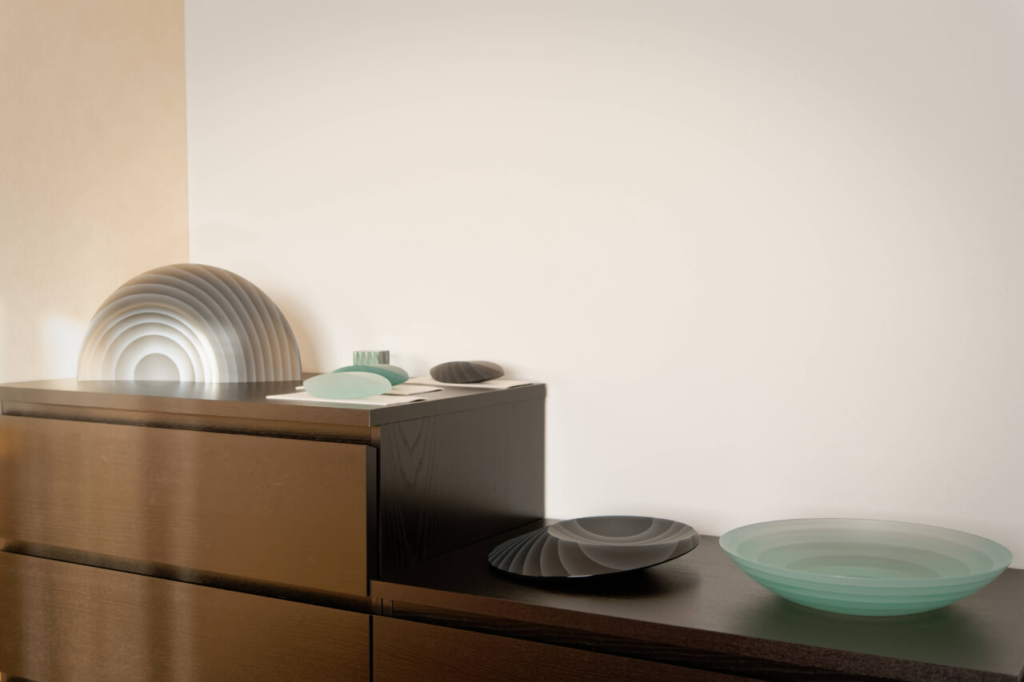
When he was preparing to take the entrance exam for Tama Art University, Kojima was unsure which department to apply for. He was interested in all aspects of making things, and wanted to learn about a variety of materials before deciding, so he didn’t have a clear idea of what he wanted to do. At the time, if you wanted to study crafts at Tama Art University, you had to apply to the Craft Design Department, which was part of the 3D Design Course. If you wanted to study ceramics, you had to go into the oil painting department, and it was more art-oriented than craft, so it was a little different from what Kojima-san had expected. So he decided to apply to the Craft Design Department, but he could choose between metal and glass, and after hesitating over which one he should choose, he decided that glass looked more fun, and he circled the word “glass” on the application form, thinking “if I have to say one or the other”. That was his first encounter with glass.
It wasn’t a decision made with a strong sense of purpose, but rather a path that led to glass. She says that during the first half of her university life, she didn’t really know what she was doing and felt a bit lost, but by the second half of her third year, she finally started to feel that she was enjoying herself.
Then, finally, she reached her fourth year. With the sole aim of continuing to create works, Kojima applied for a trainee position at the Kanazawa Utatsuyama Craft Workshop, a glass studio in Kanazawa, the hometown of her mother. It was the place where she was born and the workshop she had dreamed of working at, but unfortunately she was not accepted. “Even my friends were surprised that I wasn’t accepted, and all I could think about was continuing to work at that workshop,” says Kojima, who was stunned by the result. While she tried to come to terms with the situation, she chose to work as a part-time worker to save money and think about what to do next. During that time, she worked hard away from glass, but her desire to be involved in glass never disappeared.
In order to satisfy this desire, I started attending a glass-blowing course in Tokyo, and this turned out to be a turning point. The owner of the studio where I was taking the course was an alumnus of the Toyama City Institute of Glass Art in Toyama Prefecture, and he recommended that I enroll there if I wanted to continue working with glass.
Supported by the environment of “Toyama, the City of Glass”, I naturally found myself on the path to becoming an artist.
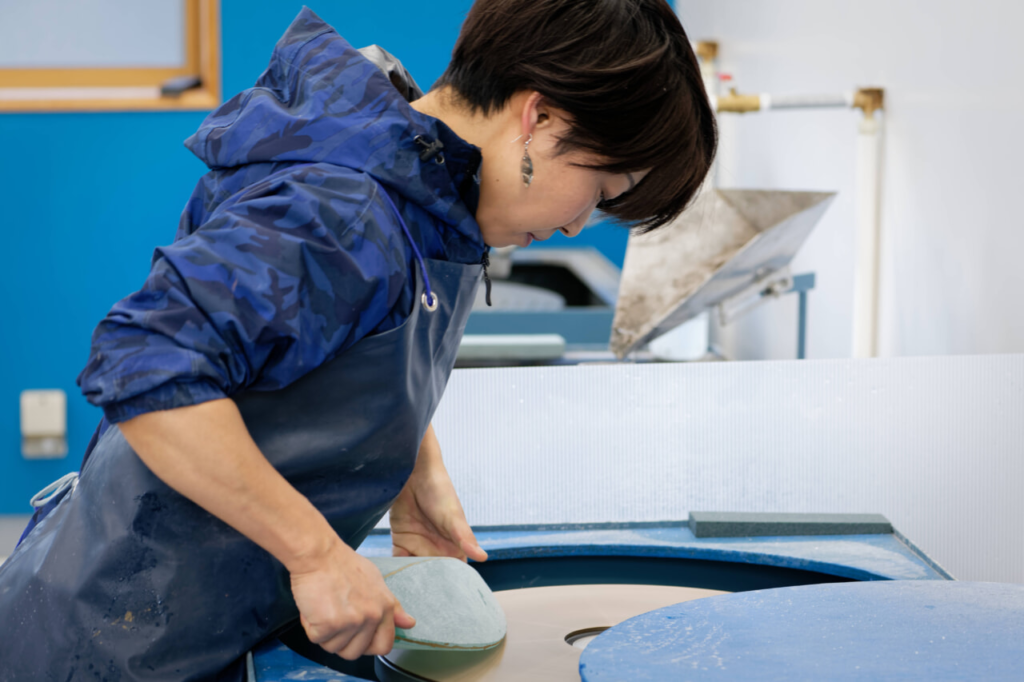
After entering the Toyama City Institute of Glass Art, Kojima became absorbed in his studies like a fish in water, and learned all there is to know about glass. However, the problem was what to do after graduation. How would an ordinary person make a living from glass? Looking back on those days, Kojima’s words reveal no trace of the hardships he faced.
“I knew I could continue working with glass in Toyama. I wanted to continue working with glass, even if it meant doing part-time work.”
The reason he can say this so easily is because of the support he receives from the “City of Glass, Toyama”. For example, the Toyama Glass Studio in Toyama City not only has facilities where visitors can experience glass culture, but also provides artists with exhibition spaces and handles the sale of their works through an online store, so there is a support system in place to help artists make a living. You can also rent studios and tools at low prices. It is not an exaggeration to say that almost everything you need for your creative work is available here. It is no wonder that Kojima thought he could work as an artist here. As a result, he has lived in Toyama City for over 20 years, even though he only planned to stay for the two years he would be attending the institute. He has even set up his own studio in the city.
The works are created by repeatedly pasting, cutting, and polishing.
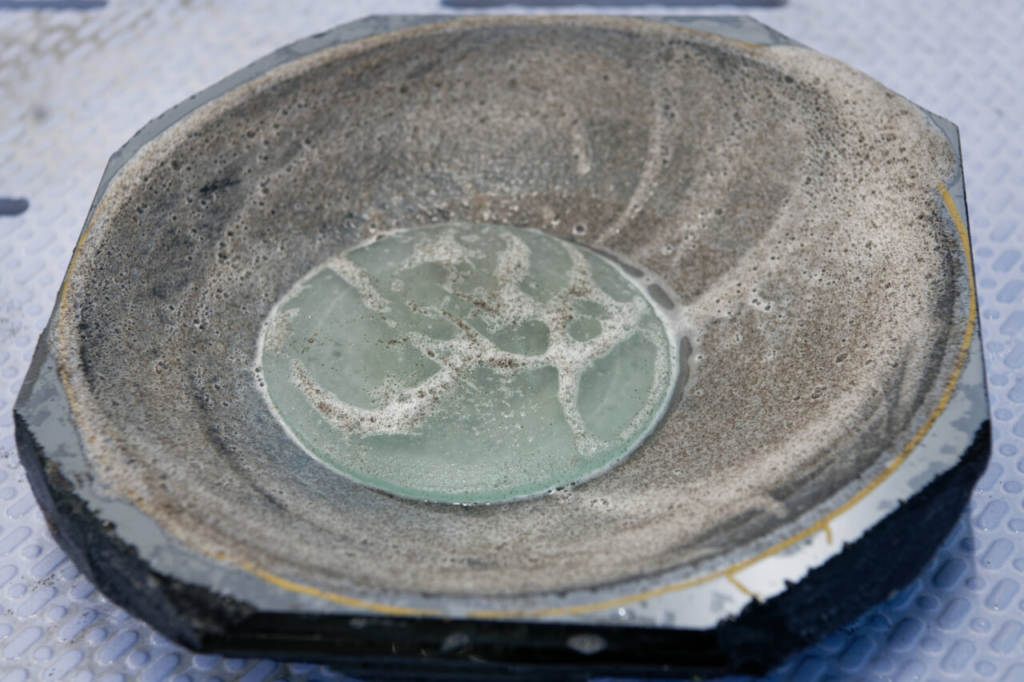
“I think that the fact that there were not many competitors was a big factor in my being able to work as an artist up to this point,” says Kojima. Certainly, when people hear the word ‘glass craft’, they tend to imagine blown glass. However, as mentioned at the beginning of this article, Kojima’s works are made from laminated glass. How are these unique works made?
The glass used is flat glass that is used as a building material. They are used in combination, choosing from among several types of color and thickness for industrial use. They are attached together using a special adhesive. Care must be taken not to let air bubbles or dust get in, as this would spoil the beauty of the work. However, because the material is glass, it is heavy. It is not the same as layering drawing paper. Layers are formed on the inside of the work, creating an artistic pattern. When the work is finished, it weighs several tens of kilograms, but this is shaved down using a grinder. The material is strong and hard, and is used as a building material, so it takes a long time to grind it down. After roughly cutting out the shape, the polishing process begins. A little sand and water is dripped onto a steel disc, and the glass itself is also covered in water and polished. The water protects the glass, and the sand acts as an abrasive. The final shape is adjusted while measuring the size to the nearest millimeter, and the surface is polished. All works, regardless of size, from large objects to accessories such as earrings and pendant tops, go through this process to be completed. It is said that the weight of the finished work is reduced to about one-third to one-quarter of its original weight after being laminated. That’s how much is shaved off. It’s a process that makes you feel faint just thinking about it, but Kojima-san laughs nonchalantly, saying, “Thanks to this, my arms and fingers have gotten thicker.”
The reason he has been able to win so many awards is that he has been honest about his feelings of enjoyment.
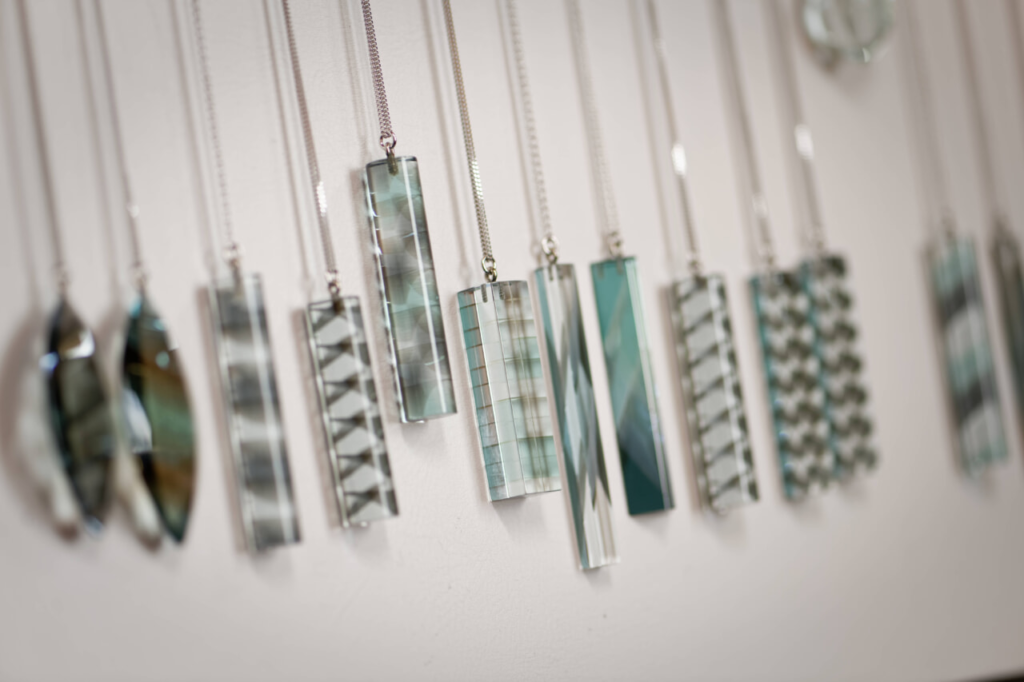
As mentioned above, making works using laminated glass is time-consuming and labor-intensive. Compared to blown glass, you can’t decide on the color or shape freely either. However, for Kojima, who couldn’t find any enjoyment in the fluid, quick process of blown glass, the process of slowly and gradually chipping away at the shape was like raising a child, and the sense of achievement when it was finished was even greater.
At university and at the Toyama research institute, he was taught both blown glass and laminated glass. However, Mr. Kojima chose his current path because he felt that the process of making objects by hand, measuring out the size and angle in centimeters and degrees, suited his personality better than blowing glass. He humbly says that the fact that there were few competitors was just a coincidence, but it was probably because he was able to pursue his own interests purely that he was able to forge a connection with Toyama and refine his individuality, leading to him winning various art prizes.
The year after graduating from the Toyama City Institute of Glass Art, he won the 10th Anniversary Special Prize at the ‘International Exhibition of Glass Kanazawa 2007′, and since then he has continued to receive high praise both in Japan and overseas for his outstanding technique and unique works, including the Takamatsu-no-miya Memorial Prize at the ’54th Japan Traditional Crafts Exhibition’ and the Grand Prize at the ‘4th Contemporary Glass Triennial in Toyama 2011’.
Spreading the appeal of glass from Toyama to the world
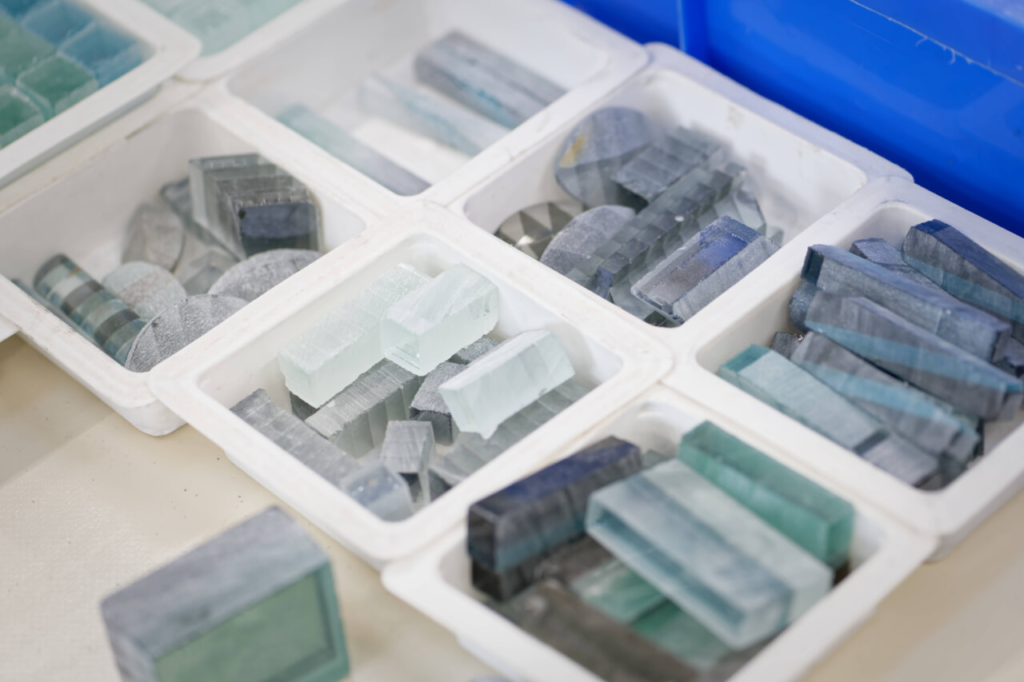

From the outside, it might seem like a challenge to compete with extraordinary “works” like Kojima-san’s, rather than with more conventional products like glasses and containers. However, Toyama has a culture that recognizes and appreciates this as art. For example, the Toyama City Institute of Glass Art, which was established with the backing of the Toyama City government, attracts talent from all over the world, and people work hard every day to improve their glass-making skills. There are also many people in Toyama City who are interested in art, including the Gallery NOW, which opened in 1989 and has unearthed many artists of value who will be remembered in future generations while looking at the past and the present. Mr. Kojima believes that putting down roots in Toyama and playing a part in communicating the appeal of Toyama’s glass culture is a way of repaying the debt he feels to this place that has helped him to become a glass artist.
Recently, Kojima’s works have been in demand for decorating hotel and apartment entrances, and as objects to display in shops. Their unique presence, which emits a mysterious light, instantly captivates the viewer. Kojima says of these works, “I think they were born because they are from Toyama”.
Indeed, you can feel the soft texture and warmth created by natural light in Kojima’s works, which are inspired by the nature that surrounds him. “I want to make something that will make people gasp when they see it. I had a Czech teacher at the Toyama City Institute of Glass Art, so I’d like to be able to exhibit my work in the Czech Republic too,” he says, his gaze now fixed firmly on the world.
